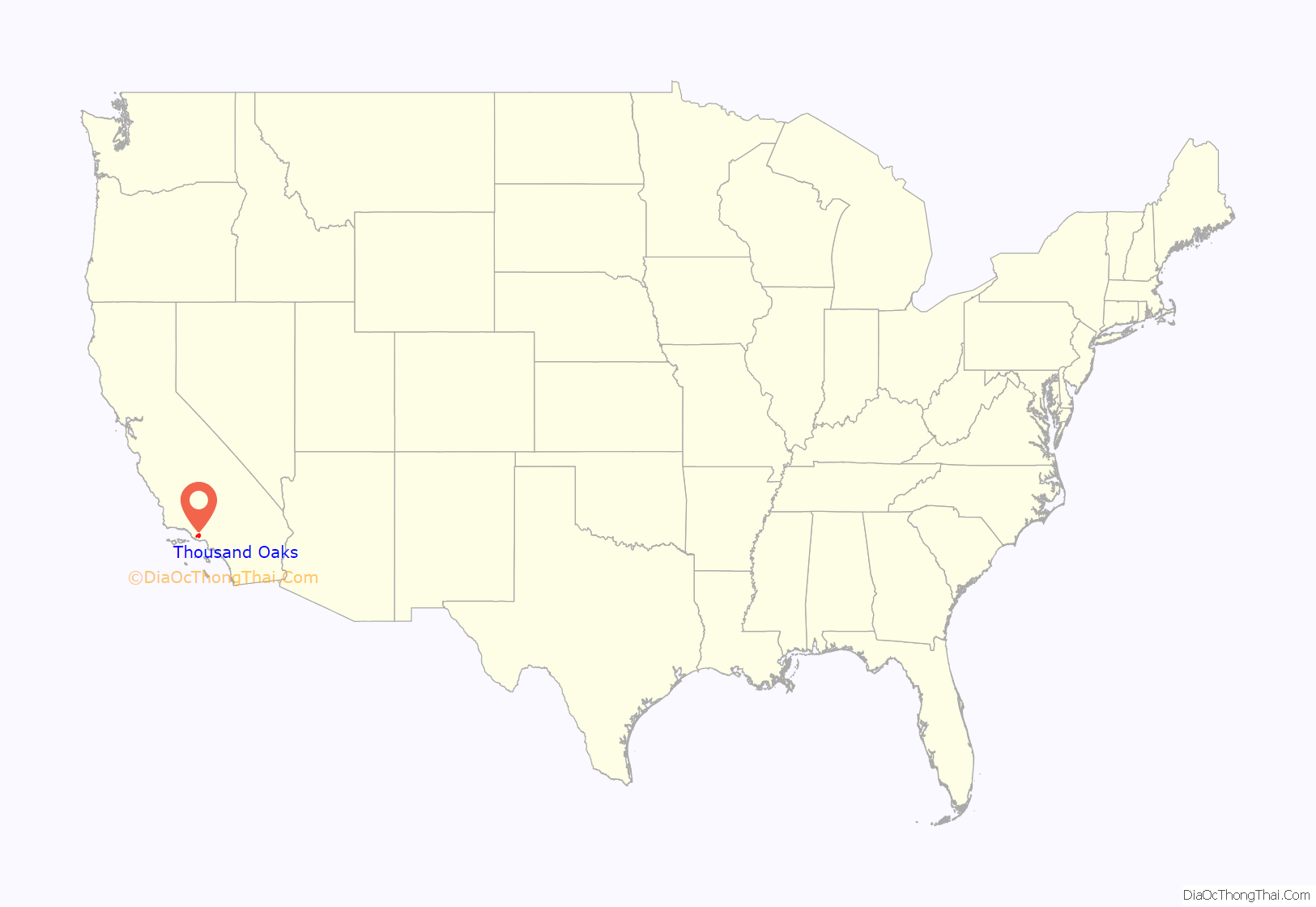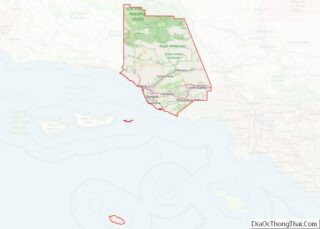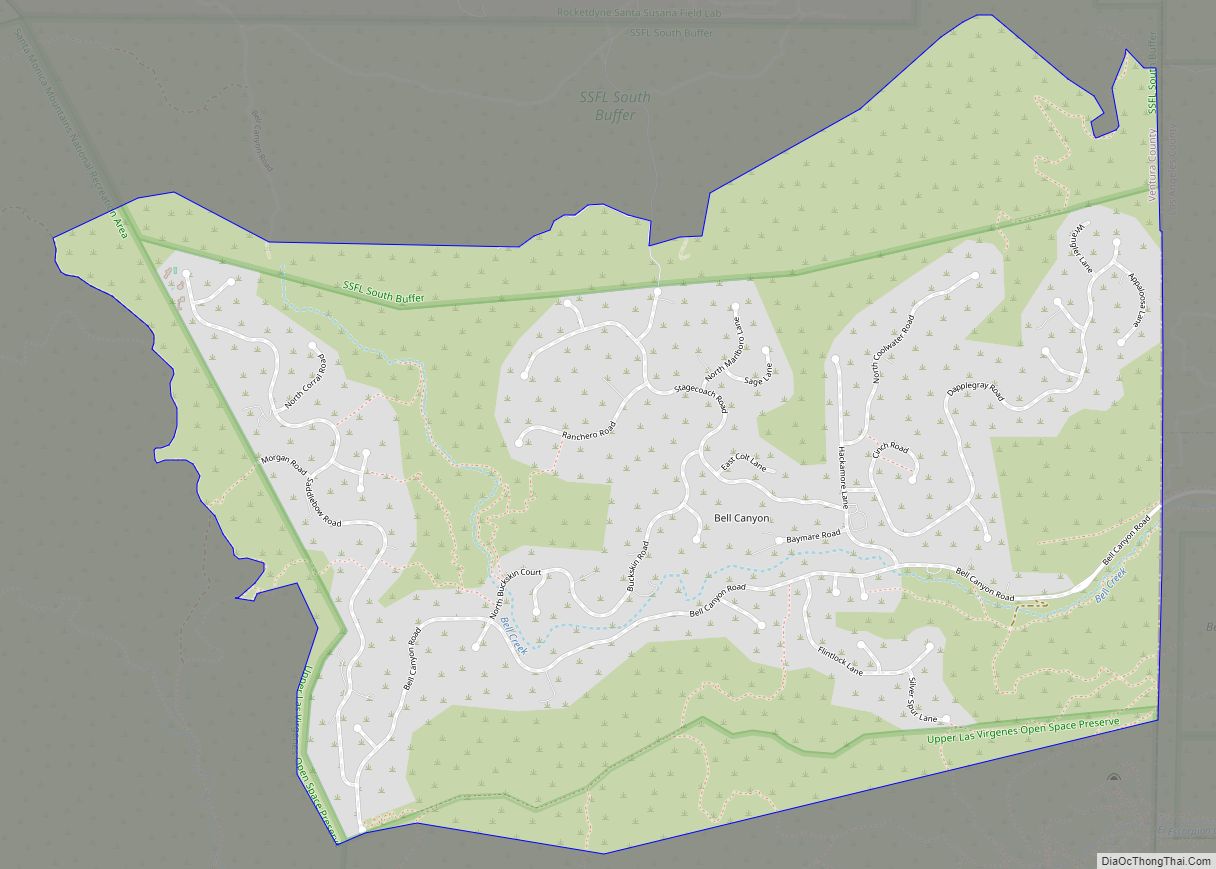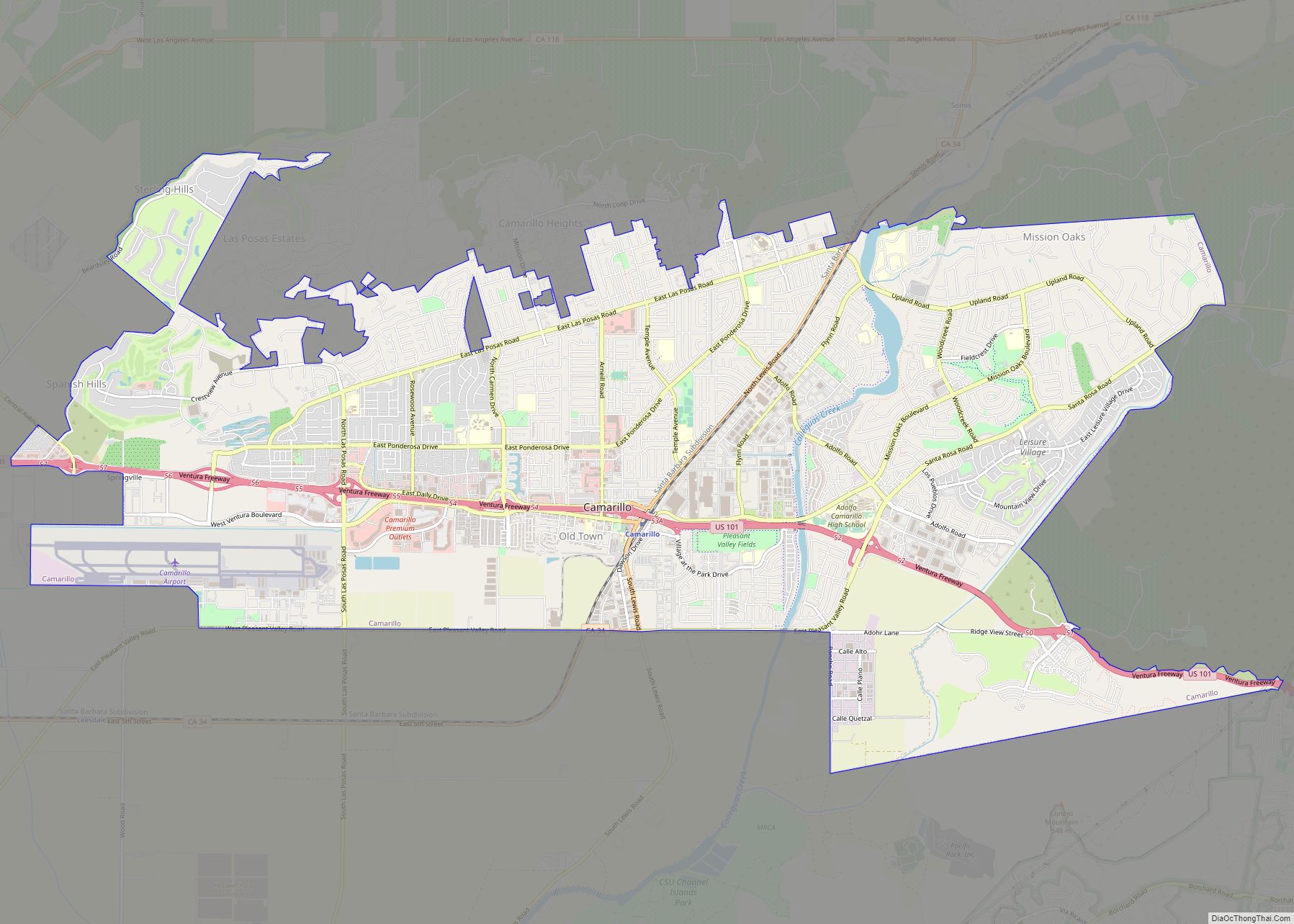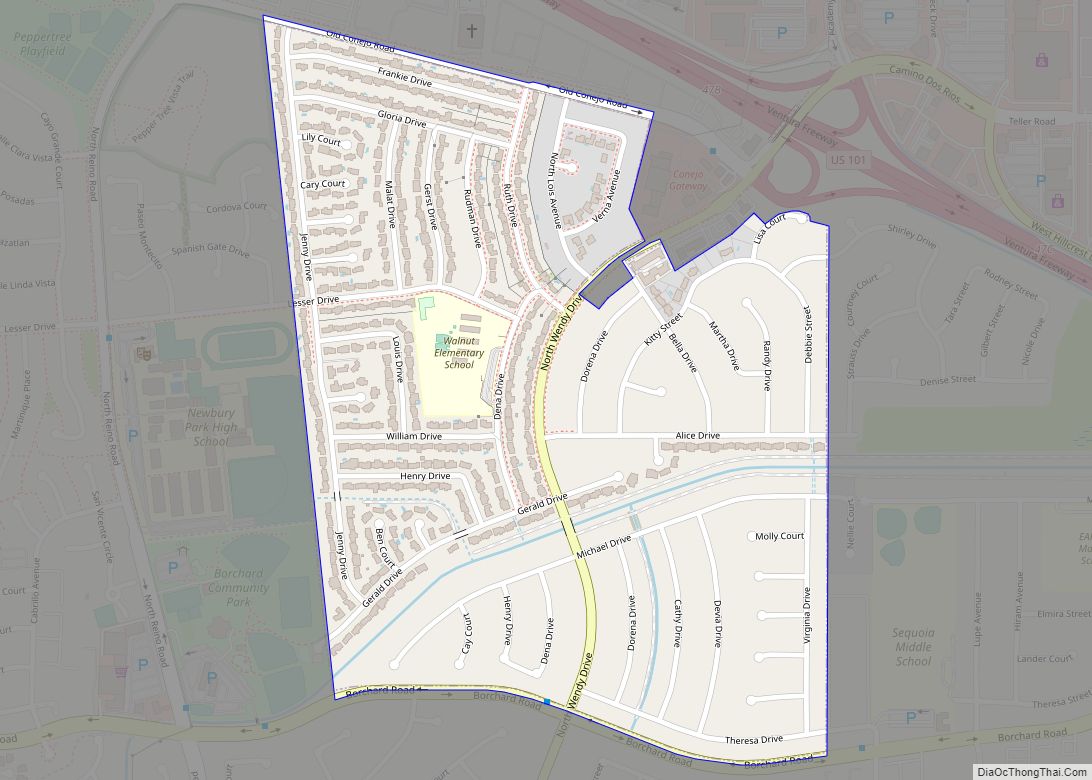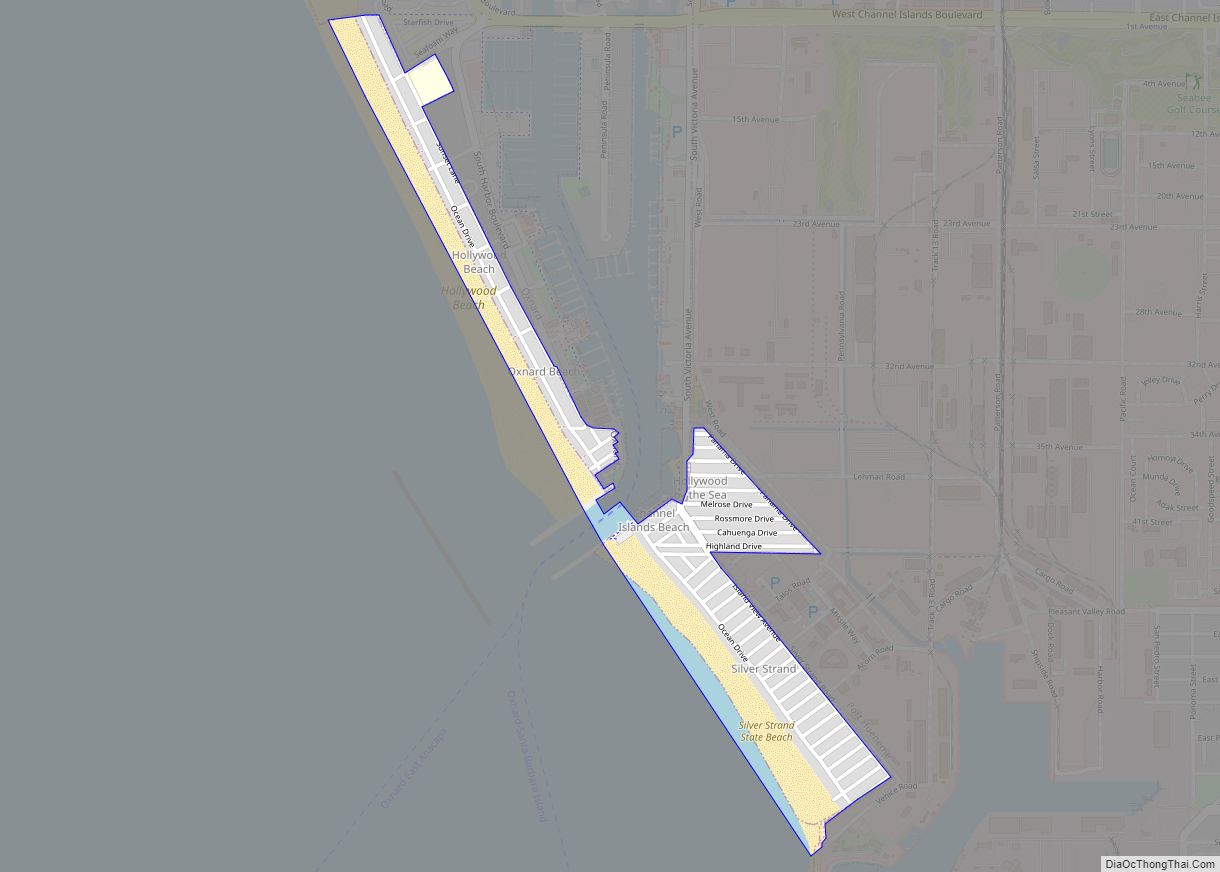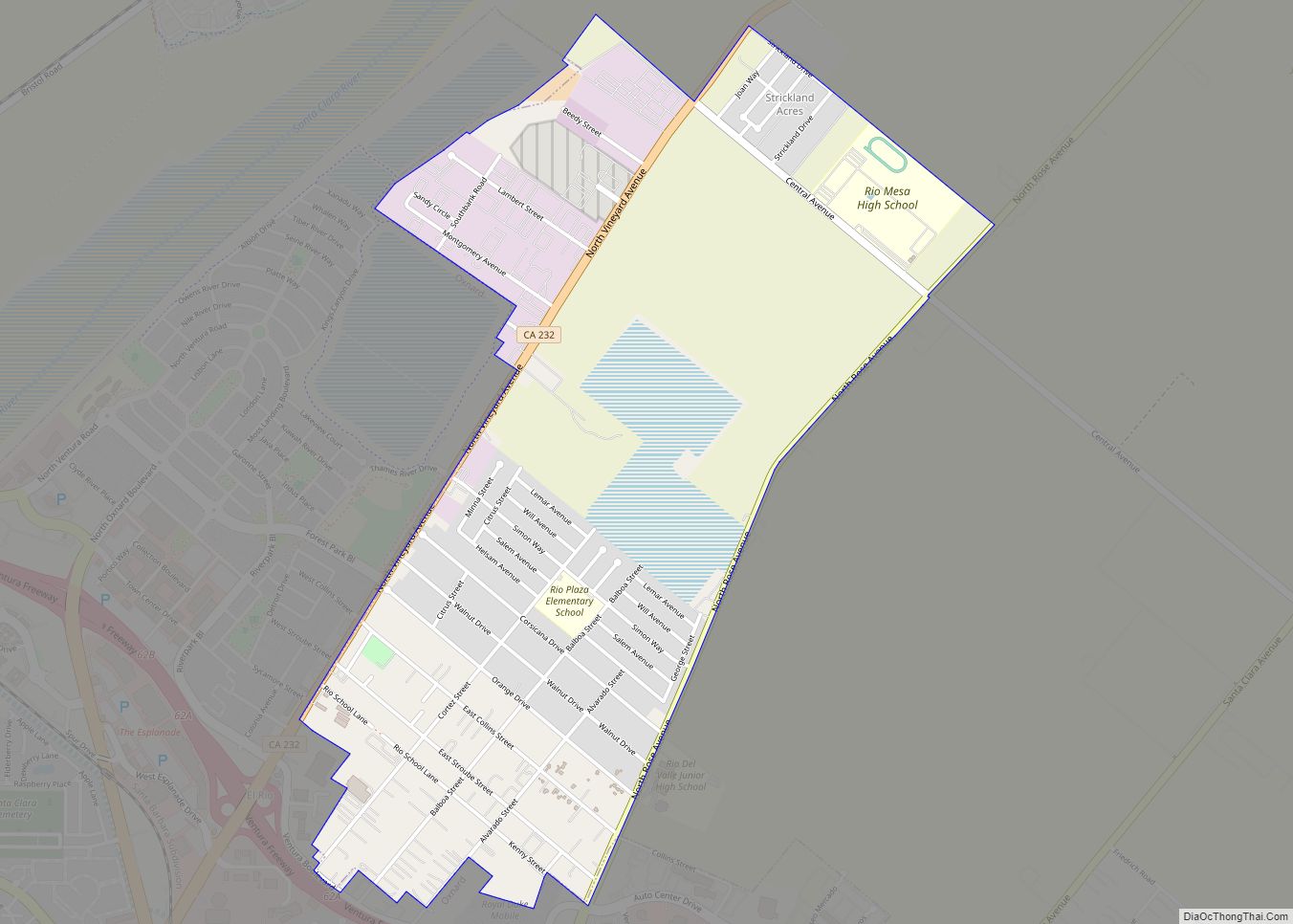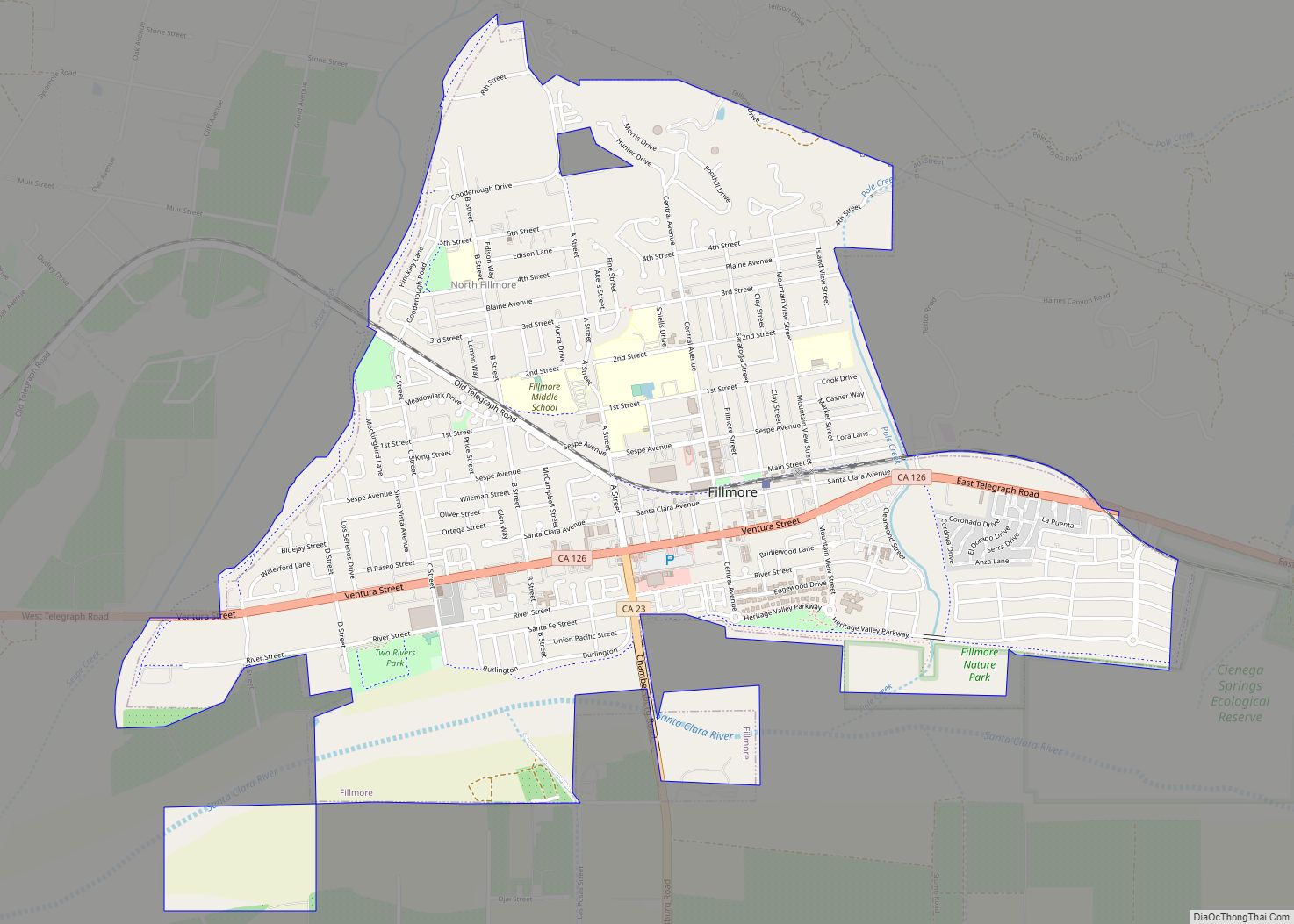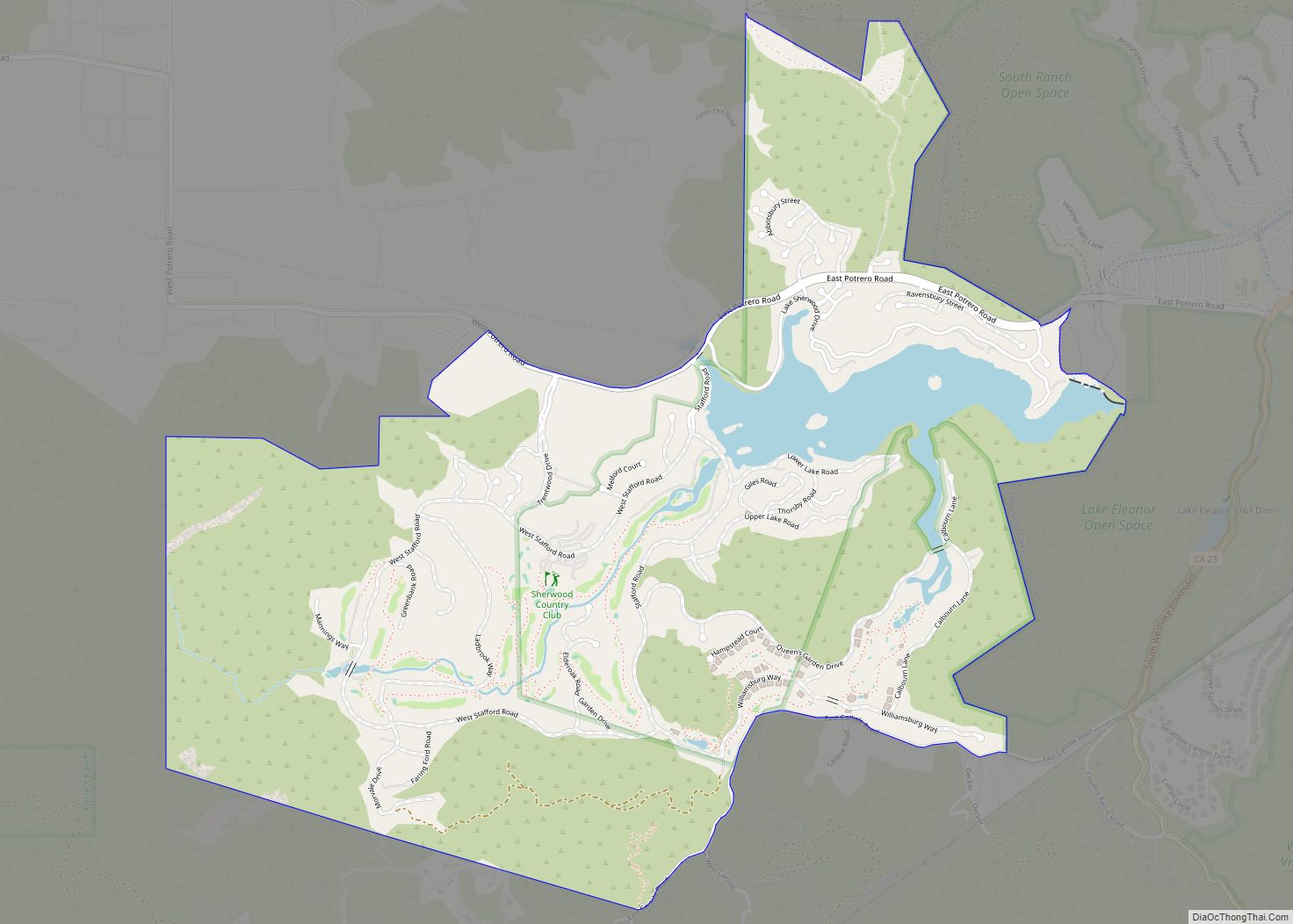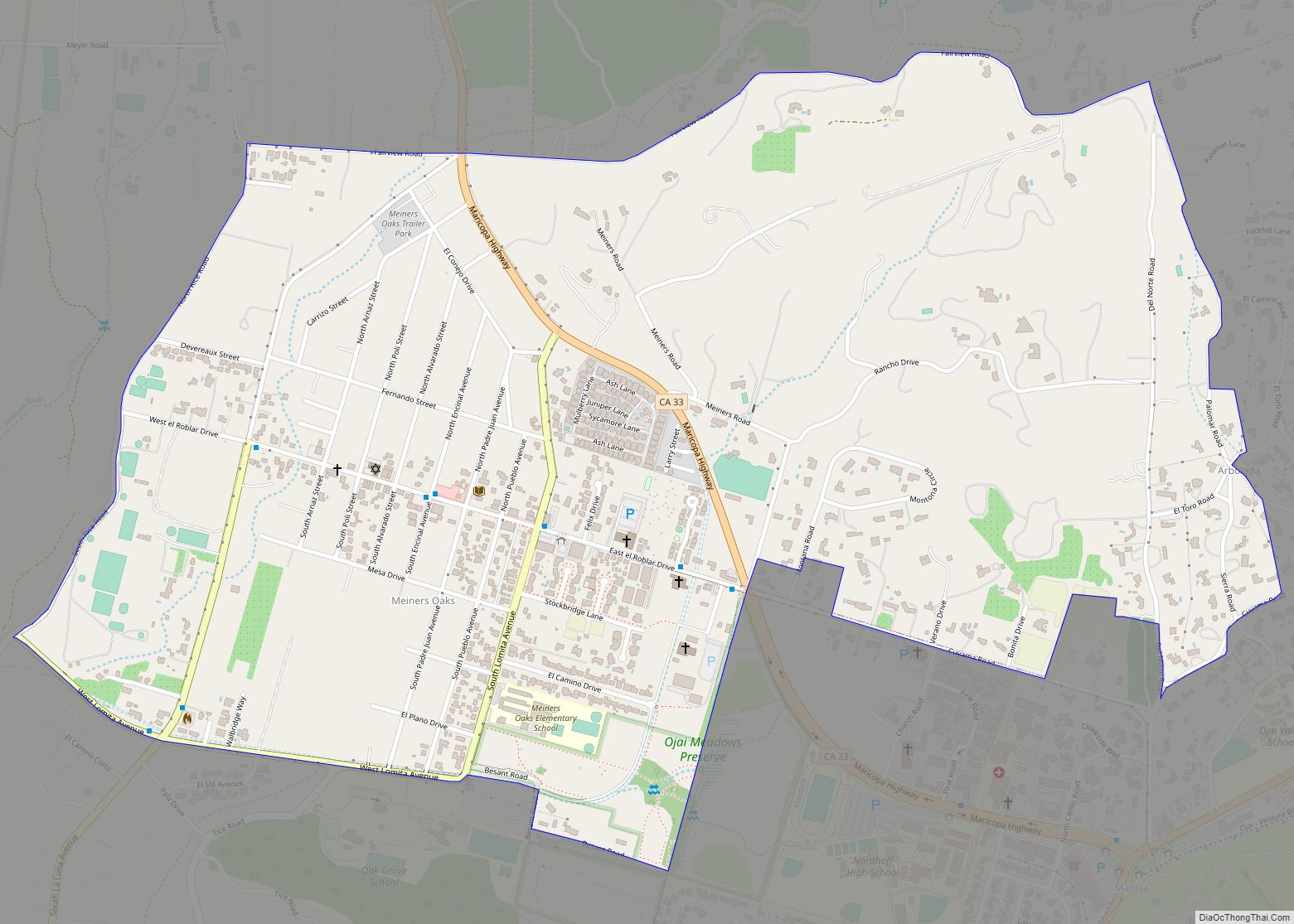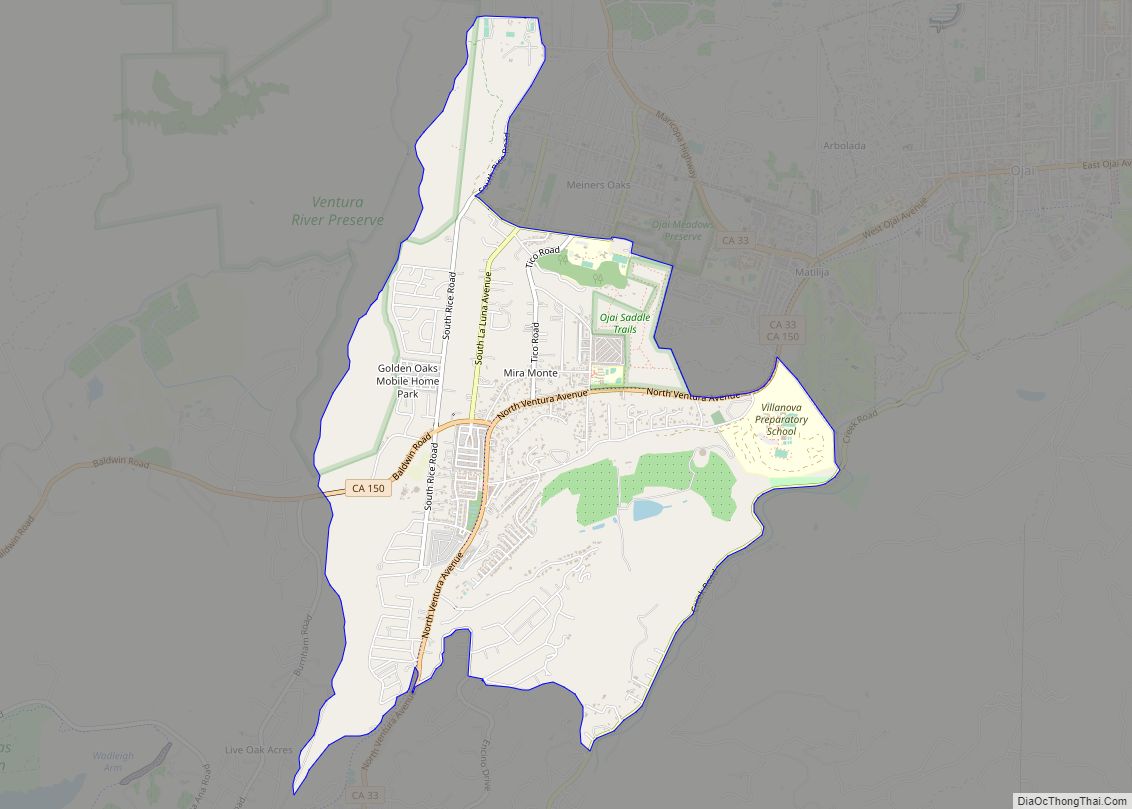Thousand Oaks is a city in the northwestern part of Greater Los Angeles, approximately 15 miles (24 km) from the city of Los Angeles and 40 miles (64 km) from Downtown. The second-largest city in Ventura County, California, it is named after the many oak trees present in the area.
The city forms the central populated core of the Conejo Valley. Thousand Oaks was incorporated in 1964, but has since expanded to the west and east. Two-thirds of master-planned community of Westlake and most of Newbury Park were annexed by the city during the late 1960s and 1970s. The Los Angeles County–Ventura County line crosses at the city’s eastern border with what is today known as Westlake Village. The population was 126,966 at the 2020 census, up from 126,683 at the 2010 census.
| Name: | Thousand Oaks city |
|---|---|
| LSAD Code: | 25 |
| LSAD Description: | city (suffix) |
| State: | California |
| County: | Ventura County |
| Incorporated: | October 7, 1964 |
| Elevation: | 886 ft (270 m) |
| Land Area: | 55.26 sq mi (143.13 km²) |
| Water Area: | 0.14 sq mi (0.38 km²) 0.27% |
| Population Density: | 2,300/sq mi (880/km²) |
| Area code: | 805/820 |
| FIPS code: | 0678582 |
| Website: | www.toaks.org |
Online Interactive Map
Click on ![]() to view map in "full screen" mode.
to view map in "full screen" mode.
Thousand Oaks location map. Where is Thousand Oaks city?
History
Etymology
One of the earliest names used for the area was Conejo Mountain Valley, as used by the founder of Newbury Park, Egbert Starr Newbury, in the 1870s. During the 1920s, today’s Thousand Oaks was home to 100 residents. In the 1920s came talks of coming up with a name for the specific area of Thousand Oaks. A local name contest was held, where 14-year-old Bobby Harrington’s name suggestion won: Thousand Oaks. The valley is characterized by its tens of thousands of oak trees (50,000–60,000 in 2012).
When the city was incorporated in 1964, the Janss Corporation suggested the name Conejo City (City of Conejo). A petition was signed by enough residents to put Thousand Oaks on the ballot. An overwhelming majority—87%—of the city’s 19,000 residents voted for the name Thousand Oaks during the September 29, 1964, election.
Pre-colonial period
Chumash people were the first to inhabit the area, settling there over 10,000 years ago. It was home to two major villages: Sap’wi (“House of the Deer”) and Satwiwa (“The Bluffs”). Sap’wi is now by the Chumash Interpretive Center which is home to multiple 2,000 year-old pictographs. Satwiwa is the home of the Native American Indian Culture Center which sits at the foothills of Mount Boney in Newbury Park, a sacred mountain to the Chumash.
A smaller village, Yitimasɨh, was located where Wildwood Elementary School sits today. The area surrounding Wildwood Regional Park has been inhabited by the Chumash for thousands of years. Some of the artifacts discovered in Wildwood include stone tools, shell beads and arrowheads. Another small Chumash settlement, known as Šihaw (Ven-632i), was located where Lang Ranch sits today. A cave containing several swordfish and cupules pictographs is located here. Two other villages were located by today’s Ventu Park Road in Newbury Park. These were populated 2,000 years ago and had a population of 100–200 in each village. Other villages included Lalimanuc (Lalimanux) and Kayɨwɨš (Kayiwish) by Conejo Grade.
The Chumash also had several summer encampments, including one located where Thousand Oaks Civic Arts Plaza currently stands, known as Ipuc (Ven-654). Another summer encampment was located at the current location of Los Robles Hospital.
Each village was ruled by a chief or several chieftains, who often traveled between villages to discuss matters of common interest. A council of elders directed village life and organized events. Most villages had a cemetery, gaming field, a sweat house, and a place for ceremonies. Locally discovered tribal artifacts are at display at Satwiwa Native American Indian Culture Center and the Chumash Indian Museum.
The region’s recorded history dates to 1542, when Spanish explorer Juan Rodriguez Cabrillo landed at Point Mugu and claimed the land for Spain. The Battle of Triunfo, which took place by Triunfo Creek, was waged over land between native Chumash and the Spanish newcomers.
19th century
From 1804 to 1848, Thousand Oaks was part of Alta California, which originally was a Spanish polity in North America. It was the Spaniards who first named it Conejo Valley, or Valley of Rabbits. The Spaniards and indigenous Chumash clashed numerous times in disputes over land. Conejo Valley was given the name El Rancho Conejo in 1803. This year, Jose Polanco and Ignacio Rodriguez were granted El Rancho Conejo by Governor José Joaquín de Arrillaga of Alta California. The land contained 48,671.56 acres. El Conejo was just one of two land grants in what became Ventura County, the other being Rancho Simi.
As a result of the Mexican War of Independence in 1822, Alta California became a Mexican territory. In 1822, Captain José de la Guerra y Noriega filed Conejo Valley as part of the Mexican land grant. It remained a part of Mexico until the short-lived California Republic was established in 1846. It became a part of the U.S. after California gained statehood in 1850. The valley was now known as Rancho El Conejo. The ranch period began when the de la Guerra family sold thousands of acres through the 1860s and early 1870s.
Two men owned most of Conejo Valley in the 1870s: John Edwards, who came from Wales in 1849, and Howard Mills, who came from Minnesota in 1870. While Edwards owned most of present-day Thousand Oaks and Newbury Park, Mills owned most of Westlake Village and Hidden Valley. Edwards’ home was located on an acre of land where The Oaks Mall currently is located, while Mills built his home where Westlake Lake sits today. The third person to buy former Rancho El Conejo land was Egbert Starr Newbury. He bought 2,259 acres of land here in 1874, land which stretched from Old Town Thousand Oaks and into today’s Newbury Park. He later established the valley’s first post office in 1875: Newbury Park Post Office. When the Conejo Valley School District was established in March 1877, there were 126 residents living in Conejo Valley.
In the late 19th century, Newbury Park was on the stagecoach route between Los Angeles and Santa Barbara. The Stagecoach Inn (Grand Union Hotel) was built in 1876, and is now a California Historical Landmark and museum.
Norwegian Colony
Thousand Oaks was home to a Norwegian community in the late 1890s and early 1900s, known as Norwegian Colony. Norwegian settlers were among the first to settle in Conejo Valley. The Norwegian Colony was located at today’s intersection of Moorpark- and Olsen Roads, now home to California Lutheran University and surrounding areas. The Norwegian Colony constituted of over 650 acres and stretched from Mount Clef Ridge to Avenida de Los Arboles. The son of Norwegian immigrants donated his ranch to California Lutheran College in the 1950s. California Lutheran University is now home to the Scandinavian American Cultural and Historical Foundation and the Scandinavian Festival.
Many place names are named after Norwegian immigrants such as the Olsen and Pedersen families. The first Norwegians came from the village of Stranda by Storfjorden. Ole Anderson bought 199 acres here, while Lars Pederson owned 111 acres. Other Norwegian pioneers also included Ole Nilsen, George Hansen and Nils Olsen. A major contribution was the construction of the handmade Norwegian Grade in 1911, a mile-long road leading from Thousand Oaks to Santa Rosa Valley.
With no doctors or hospitals nearby, the Norwegian Colony was short-lived. The Olsen family lost seven of their ten children, while Ole Anderson, Lars Pederson, and George Hansen all died in 1901 due to a diphtheria epidemic.
20th century
Newbury Park was a more established community than Thousand Oaks at the turn of the 20th century. A few lots existed early in the 1900s, wedged between Borchard land on the south and Friedrich land on the north. The Janss family, developers of Southern California subdivisions, purchased 10,000 acres (40 km) in the early 20th century. They eventually created plans for a “total community”, and the name remains prominently featured in the city. Despite early aspirations, no large subdivisions were developed until the 1920s. The development was slow and hampered even more under the Great Depression of the 1930s. Besides agriculture, the movie industry became an important industry in the 1920s and 1930s.
Between 1950 and 1970, Conejo Valley experienced a population boom, and increased its population from 3,000 to 30,000 residents. From 3,500 residents in 1957, Thousand Oaks had over 103,000 inhabitants by 1989. While ranching and agriculture were the dominant industries until the 1950s, a number of new businesses appeared throughout the 1960s and 1970s. Particularly many high-tech firms moved to Thousand Oaks in the ’60s and ’70s. Packard Bell and Technology Instrument Company were two high-technology businesses that moved into the Newbury Park industrial park in the 1960s. Other companies that followed included Westinghouse Astroelectronics Laboratory, Semtech Corporation, Purolator Inc., and Westland Plastics.
Jungleland USA put Thousand Oaks on the map in the 1920s and helped attract Hollywood producers to the city. Hundreds of movies have been filmed in Thousand Oaks. Some of the first films to be made here were The Birth of a Nation (1915) at Jungleland USA and Roaring Ranch (1930) at the Stagecoach Inn. Thousand Oaks Boulevard was featured in the “Walls of Jericho” scenes in the film It Happened One Night (1934). A western village was erected at California Lutheran University for the filming of Welcome to Hard Times (1967), while Elvis Presley and John Wayne starred in several westerns made in Wildwood Regional Park. A nearby road, Flaming Star Avenue, is named after the film Flaming Star (1960) starring Elvis Presley, which was filmed here. Other movies filmed in the valley included Lassie Come Home (1943), To the Shores of Iwo Jima (1945) and The Dukes of Hazzard (1979–85). Dean Martin and Jerry Lewis visited Thousand Oaks for the filming of Hollywood or Bust (1956), which included a scene filmed on Live Oak Street.
Movie actor Joel McCrea, who had been advised by Will Rogers to buy land in the area, raised his family on a 3,000-acre (1,200 ha) ranch he had acquired in the early 1930s. Numerous celebrities later joined McCrea and relocated to the Conejo Valley, including Dean Martin, Bob Hope, Roy Rogers, Strother Martin, Virginia Mayo, Michael O’Shea, Ben Johnson, Slim Pickens, Ronald Colman, George Brent, Eve Arden, Alan Ladd, Richard Widmark, Charles Martin Smith, and Bing- and Kurt Russell.
While the city was home to 1,700 businesses in 1970, Thousand Oaks had 11,000 businesses in town by 1988.
The world’s largest independent biotechnology company, Amgen, was established in Newbury Park in 1980.
Louis Goebel of New York bought five lots off Ventura Boulevard (today’s Thousand Oaks Boulevard) in 1925. He worked for the Universal film studio, and decided to create his own film industry zoo after the closure of Universal Zoo in the mid-1920s. He established Goebel’s Lion Farm in 1926, situated where Thousand Oaks Civic Arts Plaza is located today. Goebel began with five lions and seven malamute dogs, but he soon acquired new animals such as giraffes, camels, hippos, monkeys, tigers, gorillas, seals and other exotic animals.
It became home to several animals used for Leo the Lion MGM logo. There were held public animal shows, which drew thousands of spectators from throughout California. The animals from the park have been used in many movies and TV series, including many of the Tarzan films; The Adventures of Robin Hood (1938), which used the site as a location, and Doctor Doolittle (1967). Goebel himself camped by the filming site of Tarzan, the Ape Man (1932) by Lake Sherwood to watch his lions during filming.
It became one of Southern California’s most popular tourists attractions in the 1940s and 1950s, when the 170-acre park offered shows, lion training, elephant rides, train rides, safari tram buses and more. The park changed name to Jungleland USA in 1956 after Disneyland was established. The park later went bankrupt in May 1969, due to competition from parks such as Disneyland, Knott’s Berry Farm and Universal Studios. The park’s 1,800 animals were sold at a public auction in October 1969.
The City of Thousand Oaks was incorporated on October 7, 1964. On September 29, 1964, voters approved the incorporation and selected the name. The incorporation became official once the certificates of election were filed with the California Secretary of State, and the record of affidavit was filed with the Ventura County Clerk.
The results of the cityhood election was clear on September 24, 1964. 2,780 residents voted to set up a city, while 1,821 had voted no to incorporation. Certain areas however tried to set up its own municipality. An attempt at a cityhood election in Newbury Park failed in 1963, as Talley Corporation and Janss Rancho Conejo Industrial Park refused to join the efforts. Reba Hays Jeffries, a local opponent of cityhood, told interviewers why she thought the cityhood election failed: Cityhood backers had to collect signatures from owners who represented 29% of the land that was to be incorporated. As the efforts collected 29% of registered voters, the measure never came on the ballot. Most Newbury Park land were annexed through the late 1960s and throughout the 1970s. Casa Conejo and Ventu Park are the only parts of Newbury Park left, which are not parts of Thousand Oaks. Lynn Ranch also decided to remain outside city limits.
Two-thirds of Westlake Village were annexed by Thousand Oaks in two portions – in 1968 and 1972. The Westlake neighborhood of North Ranch remained an unincorporated area until January 1973, when Thousand Oaks approved the annexation of North Ranch. North Ranch borders Oak Park, an unincorporated area where voters have chosen not to be annexed into Thousand Oaks. Dos Vientos is a 2,350-unit housing development which was approved by the council in April 1988. The master-planned community was the largest residential project ever in Newbury Park.
Modern history
Thousand Oaks is encouraging mixed-use retail and housing development along the downtown portion of Thousand Oaks Boulevard. The city is built-out within the confines of the Conejo Valley and has adopted a smart growth strategy as there is no room for the sprawling suburban growth the city is known for.
Increased development in Moorpark and Simi Valley in the late 1990s and early 2000s caused the Moorpark Freeway (Highway 23) to become heavily congested during both morning and afternoon rush hours. A major widening project began in 2008.
On March 30, 2016, California Lutheran University and the NFL Rams team reached an agreement that allowed the team to have regular season training operations at CLU’s campus in Thousand Oaks for the next two years. The Rams paid for two practice fields, paved parking, and modular buildings constructed on the northwestern corner of the campus.
On November 7, 2018, a lone gunman killed 12 people in a mass shooting at the Borderline Bar and Grill. Days later, the Woolsey Fire threatened the community, burning homes across Ventura and Los Angeles Counties. The fire continued most of November, charring almost 100,000 acres and consuming multiple homes in the region.
Thousand Oaks Road Map
Thousand Oaks city Satellite Map
Geography
The city of Thousand Oaks is situated in the Conejo Valley in southeastern Ventura County, halfway between Los Angeles and Santa Barbara, and 12 miles east of the Pacific Ocean. Conejo Valley lies at 900 feet; 55 of its 1,884 square miles are located within Thousand Oaks city limits. For comparison, the city is larger in area than Long Beach, CA, and 20 percent larger than San Francisco.
Designated open-space nature areas occupy 34 percent of the city as of 2017 (15,194 acres). 928 acres of the Santa Monica Mountains National Recreation Area (SMMNRA) is within the southern borders of the city. Thousand Oaks is within the Greater Los Angeles Area and is 38 miles west of Los Angeles. The closest coastal city is neighboring Malibu, which may be reached through winding roads, a bike path, or hiking trails crossing the Santa Monica Mountains. Conejo Valley is bordered by the Santa Monica’s to the south, Conejo Mountains to the west and north, and the Simi Hills to the northeast.
Newbury Park currently makes up around 40 percent of the city’s total land area.
According to the United States Census Bureau, the city has a total area of 55.2 square miles (143 km). 55.0 square miles (142 km) of it is land and 0.15 square miles (0.39 km) of it (0.27%) is water.
Although Thousand Oaks has several shopping centers, including the Janss Marketplace mall, The Oaks mall, and W. Thousand Oaks Blvd., a large portion of the city’s inhabitants live in suburban communities a distance from the commercial centers of the city. The large housing districts near Lynn Road to the north and west are an example of this sprawl, despite attempts by Ventura County planners to reduce it. Many housing tracts are surrounded by walls. This design is meant to keep heavy traffic away from residential roads.
Physiography
The physiography is dominated by prominent knolls, surrounding mountains, open vistas and native oak woodland. It is home to 50–60,000 oak trees, and the city is characterized by its many oak trees and rolling green hills.
The northern parts consist of mountainous terrain in the Simi Hills, Conejo Mountains and Mount Clef Ridge. Narrow canyons such as Hill Canyon cut through the steeper mountainous areas. Conejo Mountain and Conejo Grade are found in westernmost Newbury Park, while the southernmost parts of Thousand Oaks are made up of Russell Valley, Hidden Valley and the steep rugged slopes of the Santa Monica Mountains. The elevation ranges from 500 feet in the northwest to the 2,403 feet Simi Peak. The major drainage is Conejo Creek (Arroyo Conejo).
Wetlands include Lake Eleanor, Paradise Falls in Wildwood Regional Park, Twin Ponds in Dos Vientos and the 7-acre Hill Canyon Wetlands.
Wildlife
Thousand Oaks’ fauna includes mammals such as mountain lions, bobcats, coyotes, bears, grey fox and mule deer, as well as smaller mammals as the striped and spotted skunk, California raccoon, Virginia opossum, Audubon’s cottontail, long-tailed weasel, Botta’s pocket gopher, ring-tailed cat, California vole, western brush rabbit, western gray squirrel, and several species of rats and mice, where the most common are deer mouse and Merriam’s kangaroo rat. The mountain lions which can be encountered or observed in most larger open-spaces in the city. The city recommends hikers not to hike alone, and always to keep children near. Mountain lions have been encountered numerous times in recent years, such as in Lynn Ranch in 2017 and Newbury Park in 2016. but is usually found in the adjacent Simi Hills, Santa Monica Mountains, and the Santa Susana Mountains. The drought may have brought a bear cub into the city in 2021. The natural habitat for an abundance of native animals, such as coyotes, hawks, crawdads, ducks, turtles, mule deer, numerous songbirds, mountain lions, several species of snakes, and numerous species of raptors.
Some of the amphibians and reptiles found in Thousand Oaks include lizards such as side-blotched lizards, southern alligator lizards and western fence lizards, as well as the southwestern pond turtle and crawdads, and numerous species of snake, including southern Pacific rattlesnakes, San Diego gopher snakes, striped racers, California kingsnakes, common kingsnakes, ringneck snakes, and western aquatic garter snakes. Some amphibians found in Thousand Oaks include ensatina, slender salamander, western toad, American bullfrog, California toad, Pacific tree frog, and the California red-legged frog.
There have been observed a total of 171 bird species within the city limits. The most commonly encountered avifauna include the house sparrow, house finch, Brewer’s blackbird, California towhee, spotted towhee, oak titmouse, acorn woodpecker, and California quail. Raptor population densities in the Conejo Valley, which therefore has some of the highest quantities of raptors in the U.S. Some of the raptors found in the City of Thousand Oaks include the golden eagle, red-tailed hawk, Cooper’s hawk, marsh hawk, sharp-shinned hawk, red-shouldered hawk, ferruginous hawk, pigeon hawk, prairie falcon, turkey vulture, barn owl, great horned owl, screech owl, American kestrel, and the white-tailed kite.
Flora
Thousand Oaks is home to over 100 species of plants, while 400 species can be found within 100 sq. mi. of the city. There are four endangered plant species: Conejo buckwheat, Santa Monica dudleya, Conejo dudleya and Lyon’s pentachaeta. There are between 50- and 60,000 oak trees in Thousand Oaks. Four oak species are native to Thousand Oaks: valley oak, coast live oak, scrub oak, and Palmer’s oak. The city’s largest oak has a trunk of 12 ft. in diameter and is located at Chumash Indian Museum. Thousand Oaks has the designation “Tree City USA” and has received the Trail Town USA Hall of Fame award.
Thousand Oaks is home to endemic species found nowhere else on Earth. The wildflower species Conejo buckwheat, which is native to the Conejo Valley, is found only in Wildwood Regional Park and near the Conejo Grade. It only grows on volcanic rock, and has yellow flowers which bloom April–July. It is in danger of becoming extinct. Another endemic species to Thousand Oaks, Conejo dudleya, is found throughout the valley, including in Wildwood Regional Park and also in the Santa Monica Mountains.
A notable tree is the 300-year-old “Historic Sycamore Tree”, which is designated Ventura County Landmark No. 44 and Thousand Oaks Historical Landmark No. 2. It is located at the “Tri-Village Complex” at Stagecoach Inn, Newbury Park.
Native flora can be seen at botanical gardens throughout the city, including at Gardens of the World, Conejo Valley Botanic Garden, the ethnobotanic gardens at Chumash Indian Museum, and along the Nature Trail at Stagecoach Inn in Newbury Park.
Climate
The region experiences a warm-summer Mediterranean climate (Csb in the Köppen climate classification). Vegetation is typical of Mediterranean environments, with chaparral and grasses on the hillsides and numerous western valley oaks. Its elevation ranges from about 500 to 900 feet (excluding the mountains and hills). The area has slightly cooler temperatures than the surrounding areas, as it receives cooler air from the ocean through various hill and mountain passes. On March 10 and 11, 2006, snow fell on the peak of Boney Mountain, the first snow to fall in the area in about 20 years. Snow also fell on Boney Peak on December 17 and 18, 2008.
In line with the rest of coastal California, temperatures at solar noon tend to fluctuate between 70 and 80 °F (21–26 °C) during summer, and rarely drop below 60–65 °F (15–18 °C) during winter.
The Newbury Park portion of Thousand Oaks has the coolest summer weather with highs averaging about 80 degrees compared to 90 degrees for central Thousand Oaks.
See also
Map of California State and its subdivision:- Alameda
- Alpine
- Amador
- Butte
- Calaveras
- Colusa
- Contra Costa
- Del Norte
- El Dorado
- Fresno
- Glenn
- Humboldt
- Imperial
- Inyo
- Kern
- Kings
- Lake
- Lassen
- Los Angeles
- Madera
- Marin
- Mariposa
- Mendocino
- Merced
- Modoc
- Mono
- Monterey
- Napa
- Nevada
- Orange
- Placer
- Plumas
- Riverside
- Sacramento
- San Benito
- San Bernardino
- San Diego
- San Francisco
- San Joaquin
- San Luis Obispo
- San Mateo
- Santa Barbara
- Santa Clara
- Santa Cruz
- Shasta
- Sierra
- Siskiyou
- Solano
- Sonoma
- Stanislaus
- Sutter
- Tehama
- Trinity
- Tulare
- Tuolumne
- Ventura
- Yolo
- Yuba
- Alabama
- Alaska
- Arizona
- Arkansas
- California
- Colorado
- Connecticut
- Delaware
- District of Columbia
- Florida
- Georgia
- Hawaii
- Idaho
- Illinois
- Indiana
- Iowa
- Kansas
- Kentucky
- Louisiana
- Maine
- Maryland
- Massachusetts
- Michigan
- Minnesota
- Mississippi
- Missouri
- Montana
- Nebraska
- Nevada
- New Hampshire
- New Jersey
- New Mexico
- New York
- North Carolina
- North Dakota
- Ohio
- Oklahoma
- Oregon
- Pennsylvania
- Rhode Island
- South Carolina
- South Dakota
- Tennessee
- Texas
- Utah
- Vermont
- Virginia
- Washington
- West Virginia
- Wisconsin
- Wyoming
